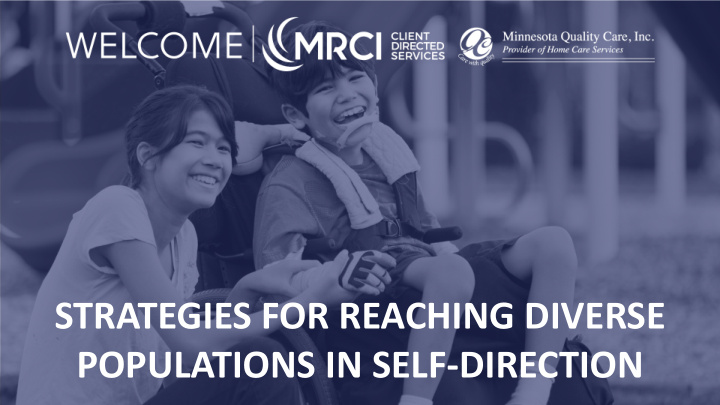



STRATEGIES FOR REACHING DIVERSE POPULATIONS IN SELF-DIRECTION
AGENDA • Changing Demographics of Clients ‐ MN Case Study of PCA Demographics • Defining Diverse Populations • Personal Stories of Success • Needs of Various Communities • Winning Strategies for Success
CHANGING DEMOGRAPHICS • Data is not easy to obtain. Often states haven’t done well capturing demographic data that is digestible. • In the State of Minnesota, there are currently (FY 2017) 43,000 people receiving PCA services through both Medical Assistance and Managed Care Organizations. Of those people, about 34,000 were using PCA Services at any given time. 73% of the recipients live in the seven county Metro area. 63% speak English, 9% speak Somali, and 8% speak Hmong. • MN PCA program is one of the most diverse LTSS programs and is growing more diverse over time. 61% of PCA recipients were people of color or Native American. • Approximately, 33% of PCA recipients were non-Hispanic white, compared to an estimated 80% of Minnesotans statewide. • 27% of the people served in this program are over the age of 65. MN Department of Human Services Personal Care Assistance (PCA) Data Summary FY 2017 Update (released July 23, 2018).
DEFINING DIVERSE POPULATIONS • Immigrants • Aging • Looking beyond race and aging ‐ Medical conditions ‐ Co-morbidity • Conditions that are complicated by primary diagnosis • Sensory issues ‐ Cultural groups ‐ Classism: not just low income folks ‐ LGBT
KYLE’S STORY Kyle and Amanda started life like everyone else. Excited about another child, ready to live out their dreams and ambitions.
SERIES OF SURGERIES AND DOCTORS
RUETER FAMILY
KYLE’S STORY • VIDEO
MORE THAN JUST ONE FAMILY
Creative solutions
PCA AGENCY CASE STUDY MN Quality Care has been working in North Minneapolis for almost 20 years.
COMMUNITIES WE SERVE
CASE STUDY IN A PCA AGENCY • Translated Timesheets • Additional Trainings • Help Above and Beyond • Program Integrity • Community Outreach • Member Referral Assistance • Emphasis on Customer Service • Grievance Process
SERVICES ABOVE AND BEYOND: READING THE MAIL • Assistance in insurance issues, SSI, Disability • Hands-on customer service • Customer interactions • Connecting them to appropriate service providers • Connecting them to other families/FB groups • Understanding documents • Reading the mail • Employment and Housing Verification forms • Local resource assistance • Paperwork assistance (I.E. faxing and copying) • Emphasizing hiring compassionate and caring staff members
STRATEGIES FOR SUCCESS What does an FMS Provider need to do to create a successful relationship with diverse populations
CULTURALLY WELCOMING FMS PROVIDERS • Provide cultural competency training for all staff • Hire staff with experience in these communities • Work hand in hand with interpreters • Promote diversity • Provide materials that have specific languages of ethnic communities you serve. • Offering additional trainings
CULTURAL APPROPRIATENESS • Same-gender case workers • Vendors with knowledge of culture • PCA staff • Take off shoes in the home • Knowledge of the role religion plays in the lives of members • Person and Family-Centered Care approach
LANGUAGE BARRIERS – INTERPRETERS • Important not to interpret word-for-word ‐ It is important to interpret the concept of the paperwork • Be willing to speak directly to person whether language is a barrier or not • If possible, hire your own staff • Check in with the company you are using, ensure they are reputable. • Use simple, easy to understand language, not technical terms • Use interpreters who abide by the Code of Ethics of Interpreting and Standards of Practice
LANGUAGE BARRIERS – BODY LANGUAGE AND TONE • Kindness is important • Being compassionate • Body language • Don’t necessarily stand the entire time (it can appear rude to some cultures) • Don’t appear disgusted by smells and condition of home
CULTURAL APPROPRIATENESS • There all different types of families • When working with adults with IDD/DD may not be their own guardian but make sure they are involved in decision-making for their life. • Mom and Dad role (don’t assume that Mom is the primary caregiver/decision maker) • Don’t assume marriage, family situation (especially in Self- Direction, the tax liability, etc.)
Outreach to the Community • Word of mouth • Social media • Hiring people who speak the language • Answering phones • Superior customer service • Community involvement
QUESTIONS
CONTACT Jennifer Drganc MRCI 507-386-5703 Abdiwadi Husen MN Quality Care 612-203-0221 Kyle Rueter MRCI 507-386-5713
Recommend
More recommend